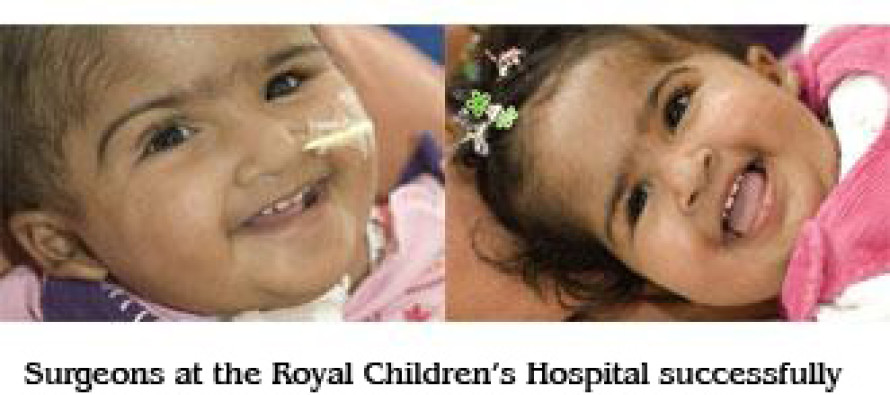Praying for Trishna and Krishna: marathon op goes on

Surgery to separate conjoined twins Trishna and Krishna continues this morning at the Royal Children’s Hospital.
“It’s going very well,” anaesthetist Dr Ian McKenzie told reporters outside Melbourne’s Royal Children’s Hospital this morning.
“Basically the kids are going very well, the team’s going very well… and they’re not separated just yet.
“It’s very fiddly.”
Dr McKenzie would not put a time frame on when the twins would be separated after their groundbreaking operation began about 8.30am (AEDT) yesterday.
”It’s all good news still, it’s progressing fantastically, we’re still in the phase of the neurosurgical part of it, so the brain is still being separated, but we are getting towards the end of that, we hope,” he said.
He said most of the bone had already been separated but there was still a defining bone joining the twins. Dr McKenzie said surgeons would be operating quite a few hours after the bone was separated.
He said concerns over problems with Krishna’s kidney had eased.
The Bangladeshi orphans were given just a 25 per cent chance of making it through the operation without harm. The hospital’s experts considered some level of brain damage a 50 per cent chance, and death was also a significant possibility.
However, surgeons were quietly confident yesterday afternoon, saying all the signs so far had been positive. ”Everyone was particularly optimistic and excited,” said plastic surgeon Tony Holmes.
Earlier operations to separate blood vessels shared by the twins had been a success with no new major connections appearing.
”If the blood vessels started to reconnect we would end up with pressure problems, but those connections didn’t seem to be major,” Mr Holmes said.
At 8am the unconscious twins were wheeled into an operating theatre usually used for heart surgery and placed face-down on two connected operating tables. For the first two hours anaesthetists worked to get the twins to the point where surgery could begin.
”There’s a lot of mucking around at the beginning of an operation like this,” Mr Holmes said. ”[It’s] mainly for positioning and getting all the tubes right so there’s no pressure on the eyes, no kinks in the tubes. Once they’re covered up, the anaesthetists have very little chance of getting in. So that took quite a while, but eventually we got knife to skin at about 10 o’clock.”
Plastic surgeons then took over, led by Mr Holmes and Andrew Greensmith, stripping back the skin that had grown over plastic extenders in order to fit over the twins’ finished heads. The cuts followed a careful curve so that when the skin was folded back over it would match the shape and hairline of the new skulls.
Midway through this process, Mr Holmes said the skin was healthy and ready for its eventual closure many hours later.
About 1pm the neurosurgeons took over, cutting into the skull to create a three centimetre by 20 centimetre ”window”.
Surgeons Wirginia Maixner and Alison Wray began the intricate work of separating the blood vessels and the brain matter that still linked the twins, while retaining enough of the bony bridge to keep the area stable.
”It’s step by step going through it,” said the hospital’s chief of surgery, Leo Donnan. ”You can’t speed it up, you can’t slow it down.”
After the neurosurgeons finished, the plastic surgeons would return, closing the brain lining and skulls with artificial caps, then closing the skin. Mr Donnan expected the work to continue into the early hours of the morning.
Mr Donnan said the teams were used to long hours and complex problems – what was new was doing several operations-in-one on two connected patients.
Up to 16 surgeons will come and go during the operation, although only a couple can work at a time.
The biggest unknown would be when the twins’ systems were separated for the first time, and their blood pressures stabilised to a new level and their bodies adjusted to a new ”dynamic”, Mr Donnan said.
After the operation, the children go to intensive care, and brain scans over the following 36 hours will indicate when to make an attempt to wake them.
But it could be weeks before it is clear whether the surgery has been a complete success.
with AAP
Atom Rahman, from the Children’s First Foundation charity in Bangladesh, was at the hospital to see the culmination of the work that began when he arranged for the twins, who turn three next month, to come to Australia.
Source: The Age | Link requested by Borhanuddin Shafi



